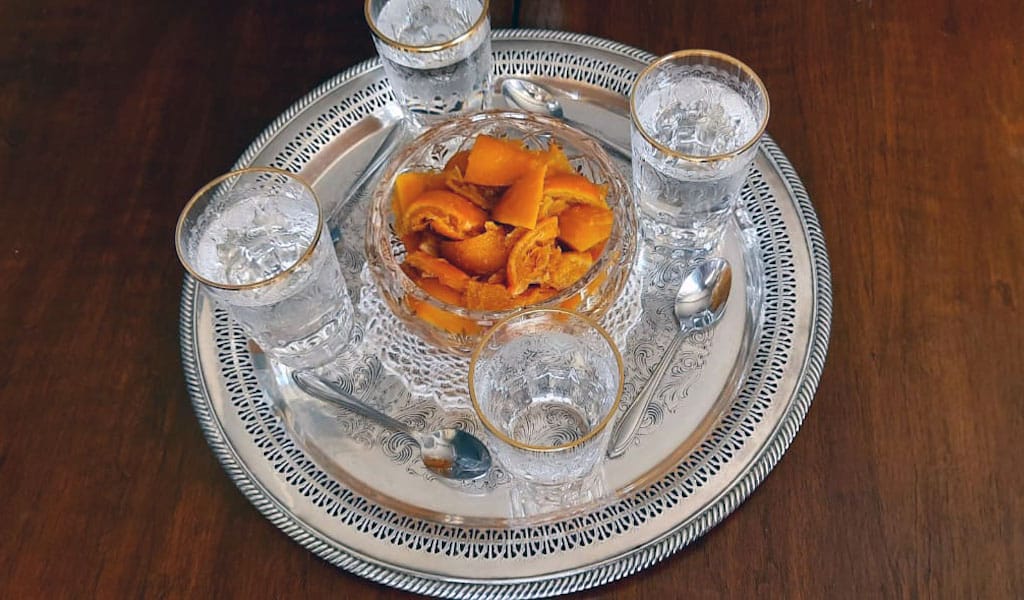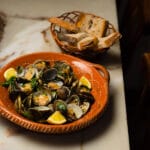“A proper Rum house has to have everything,” a venerable chef once told me in Greek, the language that we have proudly spoken within our Istanbul community for more than 2,000 years. “Spoon sweets, lakerda, pickles, liqueurs…” He then puckered his grey mustache and switched into Turkish: “Olmazsa olmaz,” which is best translated by the Latin phrase sine qua non.
Many of these essential culinary preparations appear in my novel, A Recipe for Daphne, which is both a love story and a meditation on the past and future of the community. But just who are the Istanbul Rums? The thoughts of my novel’s main character, Fanis, explain the term best:
“The doctor stared at Fanis. He probably didn’t even know that the word Rum was a Turkified version of the Greek word Romios, which meant Roman. At best, Dr. Aydemir thought of Fanis in the terms of the rest of the world, as an ‘Istanbul Greek,’ which implied that his forebears hailed from Greece and not from Istanbul. Aydemir surely didn’t know – because almost no one did nowadays – that many of Istanbul’s Greek-speaking Rums were descendants of a native population that had lived in the City since well before AD 330, the year in which Constantinople became the capital of the Eastern Roman Empire.”
Just as the community itself dates from Byzantine times, so do the essential foods that I learned to make by watching and chatting with my elders.
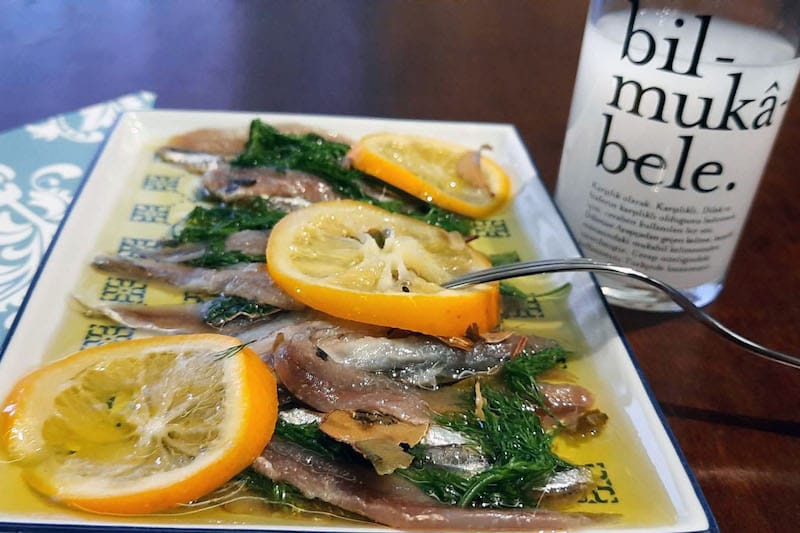
Cured Fish
Fish cured in salt was so popular in Byzantium that the 12th-century poet Ptochoprodromos mentions it often in his poems. In Ottoman times, Rums continued working in fishing and shipping, which is why many of the Turkish words for fish come from Greek. The queen of all cured fish is, of course, lakerda, which is made by soaking bonito in salt and water with a method that gives the fish a soft, buttery consistency. Sardines and hamsi (Black Sea anchovies) are cured by a simpler method using ground salt; they can later be marinated in olive oil with lemons, bay leaves and herbs. All cured fish serves as an ideal accompaniment to anise-flavored raki.
Pickles
Pickles were made from all kinds of vegetables in Byzantium. The 7th-century doctor Paulus Aegineta wrote in his book De Re Medica that they were “good for digestion” as long as one didn’t “overindulge.” I learned to pickle both in Istanbul fashion with salt or vinegar and garlic, as well as in Antakya Rum style, with garlic, hot peppers and mint. For those who prefer to buy, Istanbul is full of turşucu (pickle shops), such as the Çukurcuma shop that Fanis visits in A Recipe for Daphne: “Before continuing up Ağa Hamamı Street, where red flags and election placards waved from the lampposts, he caught sight of a nest of crazy black curls behind the great jars of preserved onions, cucumbers, tomatoes, carrots, and lemons on the shelves of the pickle-shop vitrine.”
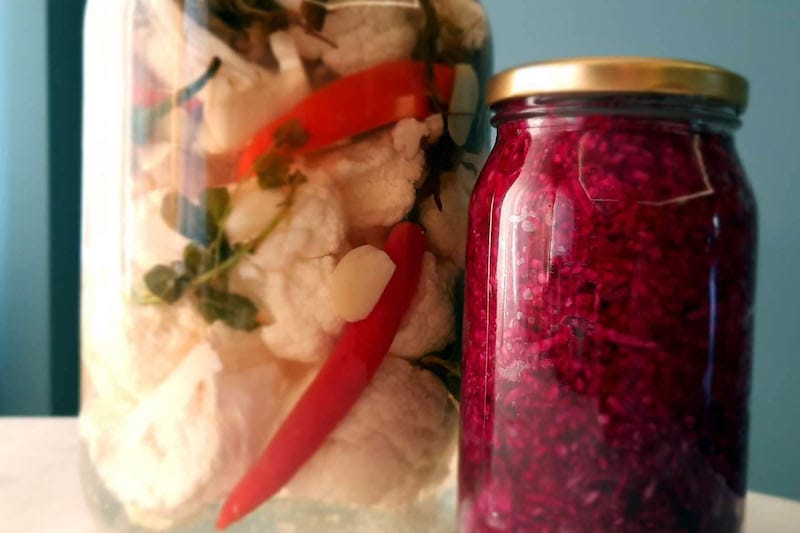
Spoon Sweets
The par excellence treats of the Rum home, spoon sweets are fruit preserves that differ from jams in that they are made with whole or large pieces of fruit, such as unripe figs, orange cubes with the peel, sour cherries, and strawberries. A non-fruit classic is rose jam (sometimes drizzled over kaymak, or clotted cream, for breakfast).
The name “spoon sweets” comes from the ritual with which they are served. A crystal bowl filled with the sweet is placed in the middle of a silver tray protected by a doily. Spoons and glasses of water are placed around the bowl, according to the number of guests. The lady of the house bows slightly with the tray; the guest dips his spoon into the bowl once, eats his sweet, drinks the water, puts the spoon into the empty glass, and replaces the glass on the tray.
Another type of spoon sweet is white aspro glyko, made from pure sugar, flavored with vanilla and served directly on the spoon in a glass of water. It is the signature treat of the Ecumenical Patriarchate in Istanbul to this day.
Liqueur
When the goddess Athena, disguised as King Mentes of the Taphians, enters the palace of Odysseus in Homer’s Odyssey, Telemachus says to her, “Come inside so that I can treat you to food and wine, and then tell me what brings you here.” The Homeric tradition of offering alcohol before settling down for conversation continues in Istanbul Rum houses, where homemade liqueurs are served both during simple visits and on special occasions. They can be made from almost any fruit, but the signature Istanbul liqueur is sour cherry spiced with cinnamon.
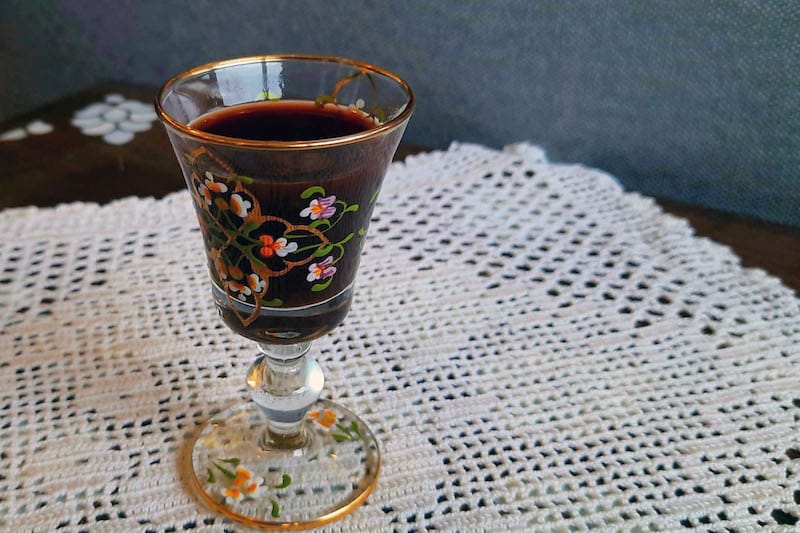
Sour Cherry Liqueur Recipe
1 kg sour cherries
500g sugar (if you like a sweeter taste you can use up to 1kg)
2 Turkish coffee cups ethyl alcohol for food use (130-150g)
2 cinnamon sticks
Optional:
4 cloves
4 whole peppercorns
1/4 lemon
3 cm piece of ginger, skin removed
In a large jar, mix the whole sour cherries with sugar and all other ingredients except the alcohol. Close tightly and let the mixture sit in the sun or on a warm windowsill for at least two weeks, agitating periodically. After two weeks, add two Turkish coffee cups of alcohol, mix well, and leave to sit at least another two weeks, agitating periodically. Taste after one month and add sugar or alcohol according to preference (you can also let it brew longer if desired). Strain and serve with one whole cherry in the bottom of each glass. The remaining cherries can be returned to the jar and kept for use in cakes or other sweets.
To convert metric measurements to US and British kitchen units, click here.
Nektaria Anastasiadou’s debut novel, “A Recipe for Daphne,” was published by Hoopoe Fiction/AUC Press in 2021. Anastasiadou is the 2019 winner of the Zografeios Agon, a prestigious Greek literary award founded in 19th-century Constantinople. She is currently finishing a second novel written in the Istanbul Greek dialect. Anastasiadou lives in Istanbul. Click here to purchase “A Recipe for Daphne.”
Nektaria AnastasiadouNektaria Anastasiadou
Published on March 01, 2021
Related stories
August 26, 2022
LisbonAlongside chef and restaurateur André Magalhães in his Lisbon restaurant Taberna da Rua das Flores, we stare down a rustic clay vessel piled with a mixture of steaming clams, fragrant cilantro and garlic, wedges of lemon…and not a whole lot more. As recommended by André (“It’s tastier if you use your hands”), we pinch the…
March 1, 2013
Athens | By Nicolas Nicolaides
AthensOnce a resort town on the outskirts of the Greek capital, Phaleron – only a few miles from downtown Athens – is now well incorporated into the city’s urban fabric. The area has remained an upscale neighborhood, but, sadly, it has lost its distinctive character: the sea is now polluted, the open-air cinemas have been…
April 2, 2024
LisbonFolar is the generic name given to traditional Easter sweet bread in Portugal. Making it from scratch is somewhat of a long process, but being confined due to the coronavirus crisis, we seem to have a bit more time on our hands than expected. My family’s folar recipe is from my grandmother Felismina, who was…







































